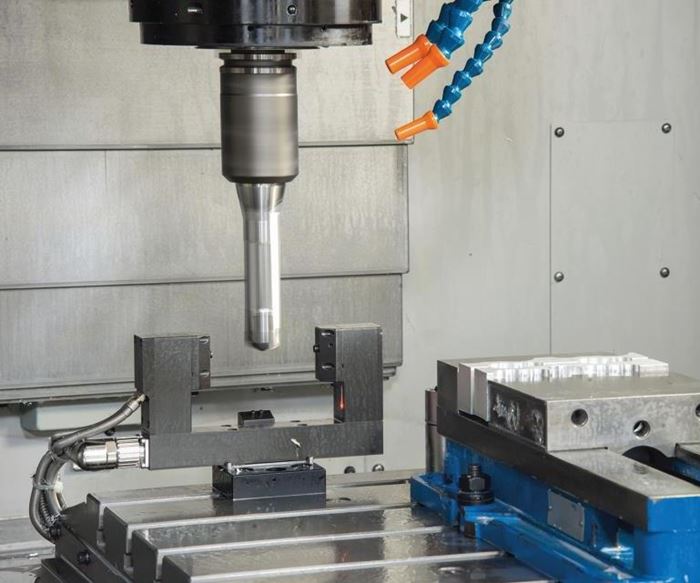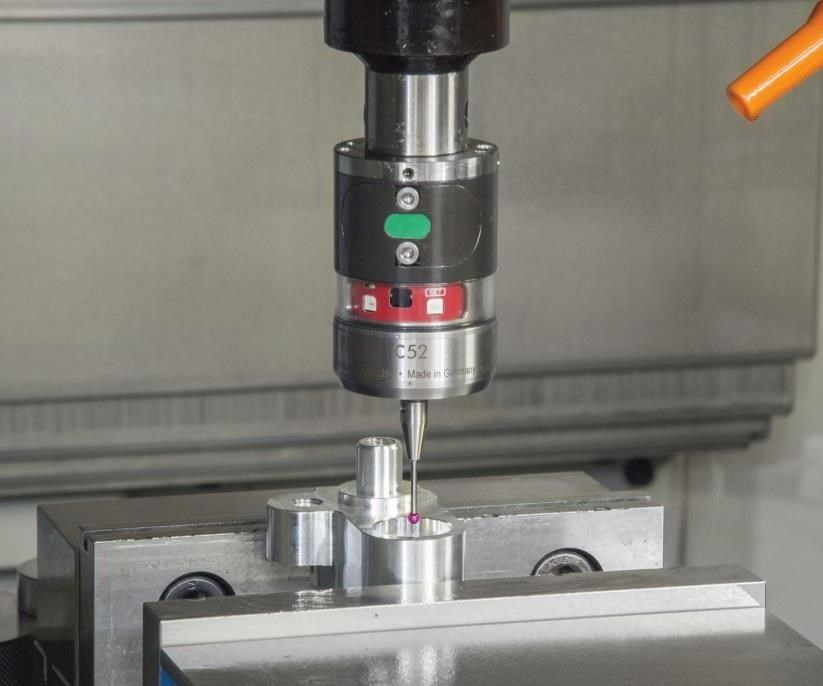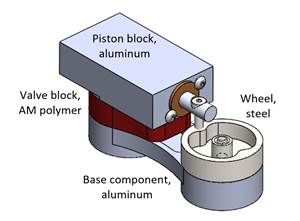Measuring Components Help Job Shop Triple Capacity
Magnolia Tooling's older, less-accurate machines required time-consuming manual setup procedures. Purchasing new machines from Makino and accessories from Blum-Novotest streamlined setup and optimized production.
Share




As machines age, shop owners often need to find creative work-arounds to meet accuracy requirements while keeping up with production demands. This can be especially difficult when trying to grow a business. Purchasing new machines and accessories can be just as challenging, as return on investment is not always clear. One shop owner upgraded his facility and equipment with state-of-the-art machinery and accessories, and though the investment was large for a small company, it meant reduced setup time and improved precision. The company says it can now handle growth while meeting its current customers’ requirements.
Based in Batesville, Mississippi, Magnolia Tooling is a privately held shop owned by Jonathan Johns, who heads its seven-person team. With the exception of one member hired five years ago, Magnolia employs the same people it did when it opened in 1998. What began with a manual mill, grinder, surface grinder and manual lathe has since grown to include EDMs, heat-treat ovens, vertical milling machines and CNC lathes. The shop runs small volumes—usually between five and 15 pieces, though sometimes only one—in materials such as hardened steel, stainless and others.
Over the years, Magnolia has found a niche in the automotive industry, with the majority of its work machining tooling fixtures for automotive suppliers. Mr. Johns knew for his business to grow, he needed to invest in new technology. His vertical machines were getting older, no longer very precise and showing increasingly more runout. Their spindles were only 4 inches in diameter, and thermal growth would negatively affect part tolerances. The excessive runout meant reduced cutting ability and tool life.
Mr. Johns decided it was time to invest in new equipment when a potential customer asked the shop to produce one to three precision parts at a time. Magnolia was unable to serve that customer, as its machines would not hold the tolerance and it took too much time to set up for such a short run.
Even for existing customers, Magnolia was spending large amounts of time meeting requirements. For example, the shop typically turned a part three times during manufacturing: It machined one side, turned the part over, machined the next side, then turned it sideways and repeated. Machine operators manually found the new surface each time using feeler gages and “johnny blocks,” gage blocks of a known length/width, to confirm part placement and tool offset.
The challenge was not only the slow manual setup; it was also the work-arounds to achieve accuracy. Operators would get a part within half a thousandth or a thousandth of an inch larger than the specification, cut the part a second time, check it and cut it again until they had the right size.
On the recommendation of an industry colleague, Mr. Johns decided to purchase new VMCs from Makino Inc. (Mason, Ohio). He met with Tom Van Hersh, a Makino sales representative with Single Source Technologies, who insisted that Magnolia also include accessories from Blum-Novotest Inc. (Erlanger, Kentucky) to really get the most out of the new equipment. He recommended the Blum TC50 touch probe and Blum LaserControl Micro Compact NT tool-setting laser.
Magnolia added another 2,400 square feet of space to its facility, bought the Makino machines (one PS95 and two PS65s, all of which were installed the first quarter of 2016), and added the Blum probe and laser to each. The improvements represented a significant spend for a small shop.
“The results, however, were worth it,” Mr. Johns says. “We never had that kind of automation, and now I can’t imagine how we ever made it without them.”
The Makinos are fast and accurate; however, they do not automatically sense part location or tooling within the machining space, and this is why Magnolia included Blum’s probes and lasers.
“Tom said, ‘You can’t realize your investment if you’re going to continue an old-fashioned way of picking up parts and setting tools with jig blocks,’” Mr. Johns says.
The Blum probe reduces the time it takes to set up a workpiece in the machine tool and can also be used to verify dimensions once the workpiece has been cut. The machine’s coordinate system indicates the position of the workpiece within the its work envelope and records this location in the control’s part parameters. This information, along with tool dimension data, indicates exactly where the part is and how it is orientated in the machine.
The Blum laser operates similarly, but it uses light to measure the tool while it is rotating at actual cutting speed. This reduces setup time and can also be used after a cut to ensure the tool is not broken or worn. Any change in length, radius or corner radius is automatically updated in the control, ensuring accurate cuts. Magnolia employees simply eyeball placement of the probe close to the part, hit the start button, and let the probe automatically come down and confirm the part’s location within seconds.
“Now when we make a part, it’s perfect the first time,” Mr. Johns says. “In one 10-hour day, three machinists might go through one to five different jobs each, so it’s a lot of in and out, a lot of setup time.”
The Blum components are the new workhorses at Magnolia, he says. “If you’re running 40 parts, you can tell it: ‘After three parts, take the probe and confirm this part.’ The tolerance gets recorded in the program. If the Blum TC50 probe senses a problem, it will stop the machine or fix it. The Blum tool setter can re-compensate the tool so we can go back and recut it to the right size. The probe won’t let you make a bad part. It takes all the human error out of the process.”
Prior to integrating Blum’s lasers and probes, jobs could take as long as 11 hours to run. Mr. Johns says Magnolia has since tripled its capacity, delivering high-precision, small-batch work to more customers.
Aside from improvements from the measuring components, the machine tools themselves also have provided a variety of benefits. For example, the new spindles extend tool life and performance, Mr. Johns says. “They’re big. The heads are cooled. You can run the spindles at 14,000 rpm all day long and their heads stay at a constant temperature,” he says. As a result, Magnolia is not buying as many end mills.
“These new machines have nearly eliminated the grinding we used to do because they give you such a good surface finish,” he says. “We used to have to grind a 1.5- by 2.0- by 2.5-inch block. The Makinos will cut that whole block out—the sides, the top—and it looks just like it’s ground. We knocked 14.5 hours off of a 48-block job because we didn’t have to go to the grinder anymore.”
With increased efficiency, Mr. Johns began actively looking for more work and new clients. With the new machines in place, he invited prospective customers, including a maker of high-precision medical equipment, to his shop. “Once they looked at the shop and saw our machines had part probes and tool-setting lasers, they said, ‘We’re going to give you a shot,’” he says.
Now, he’s happy to share his positive experience of upgrading to higher-quality machine tools and automation systems. “It seems hard to spend that much money to upgrade that far ahead, but if you have the work, it will easily pay for itself in one year.”
Related Content
Solve Worker Shortages With ACE Workforce Development
The America’s Cutting Edge (ACE) program is addressing the current shortage in trained and available workers by offering no-cost online and in-person training opportunities in CNC machining and metrology.
Read MoreWorkholding Fixtures Save Over 4,500 Hours of Labor Annually
All World Machinery Supply designs each fixture to minimize the number of operations, resulting in reduced handling and idle spindle time.
Read MoreFinding the Right Tools for a Turning Shop
Xcelicut is a startup shop that has grown thanks to the right machines, cutting tools, grants and other resources.
Read MoreDN Solutions Responds to Labor Shortages, Reshoring, the Automotive Industry and More
At its first in-person DIMF since 2019, DN Solutions showcased a range of new technologies, from automation to machine tools to software. President WJ Kim explains how these products are responses to changes within the company and the manufacturing industry as a whole.
Read MoreRead Next
5 Rules of Thumb for Buying CNC Machine Tools
Use these tips to carefully plan your machine tool purchases and to avoid regretting your decision later.
Read MoreSetting Up the Building Blocks for a Digital Factory
Woodward Inc. spent over a year developing an API to connect machines to its digital factory. Caron Engineering’s MiConnect has cut most of this process while also granting the shop greater access to machine information.
Read MoreRegistration Now Open for the Precision Machining Technology Show (PMTS) 2025
The precision machining industry’s premier event returns to Cleveland, OH, April 1-3.
Read More






























.jpg;maxWidth=300;quality=90)










